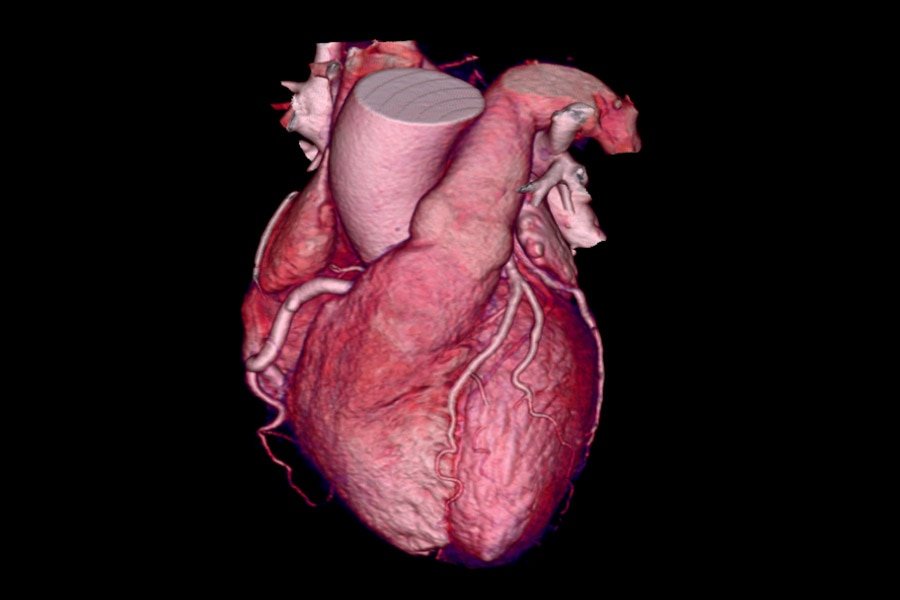CT Scanning
A traditional CT scan is an x-ray procedure that combines many x-ray images with the aid of a computer to generate cross-sectional views of the body. Cardiac CT uses advanced CT technology with intravenous (IV) contrast (dye) to visualize your cardiac anatomy, coronary circulation, and great vessels. With multi-slice scanning, it is possible to acquire high-resolution three-dimensional images of the moving heart and great vessels.
Your doctor uses the cardiac CT to evaluate:
The heart muscle
The coronary arteries
The pulmonary veins
The thoracic and abdominal aorta
The sac around the heart (pericardium)
The Suite
Our CT technologists have a combined experience of over 35 years performing CT Scans. Every effort has been made to provide you with a calm, pleasant, non-clinical environment. There are reclining chairs and a television in each waiting area and space for any guest you bring to sit with you, however, they cannot accompany you into the scanning room. Once in the scanning room, the technologists will be stationed outside the room but there is a large window between you and them and an intercom where you have continuous communication throughout the scan. The actual scan takes only seconds.
What to expect:
You will change into a hospital gown.
A nurse will insert an IV line into a vein in your arm to administer contrast (dye) during your procedure.
You will lie on a special scanning table.
The technologist will clean three small areas of your chest and place small, sticky electrode patches on these areas. Men may expect to have their chest partially shaved to help the electrodes stick. The electrodes are attached to an electrocardiograph (ECG) monitor, which charts your heart’s electrical activity during the test.
As you lie on the scanner table, you will be asked to raise your arms over your head for the duration of the exam.
During the scan, you will feel the table move inside a donut-shaped scanner. You will receive a contrast agent through your IV to help produce the images. It is common to feel a warm sensation as the contrast circulates through your body.
Once the technologist is sure that all the information is collected, the IV will be removed.
The CT scan only takes about 15 seconds to complete.
How to prepare:
Avoid any caffeinated drinks on the day before or the day of your exam. Coffee, tea, energy drinks, or caffeinated sodas.
Avoid energy or diet pills on the day before or the day of your exam (ask your doctor if you have questions).
Do not use Viagra or any similar medication on the day before or the day of the exam. It is not compatible with the medications you will receive during the procedure (ask your doctor if you have questions).
On the day of your exam,do not eat for four hours prior to your scheduled appointment. You may drink water but no milk.
You may take your medications as you normally would but we ask that you do not take any diuretics.
If you are diabetic, ask your physician how to adjust your medications the day of your test. If you think your blood sugar is low, tell the technologist immediately.
If you take Glucophage or a similar medication, you will have to refrain from taking it for 48 hours after your scan.
If you are currently taking a beta blocker, please let your doctor know.
Tell your technologist and your doctor if you are:
Pregnant
Allergic to iodine and/or shellfish or any medications
Undergoing radiation therapy
You may be required to have a blood test to evaluate your kidney function prior to receiving any contrast agent.
After the procedure:
You may continue all normal activities and eat as usual after the test.
Your physician will discuss the results of your test with you.
A note about CT and risk:
A CT scan is a low-risk procedure. Occasionally, patients experience an adverse reaction to the contrast agent. Some patients develop itching or a rash following the injection. These symptoms are usually self-limiting and resolve without further treatment. Antihistamines can be administered if needed for symptomatic relief. Rarely, a more serious allergic reaction, called an anaphylactic reaction, occurs that may result in breathing difficulty. This reaction is potentially life-threatening and would require medications and treatment to reverse the symptoms. CT scanners use x-rays. For your safety, the amount of radiation exposure is kept to a minimum. Because x-rays can harm a developing fetus, however, this procedure is not recommended if you are pregnant.
The single most important step for patients trying to determine whether they should consider a Coronary CTA is consultation with their physician. You will need to make an appointment with your doctor to evaluate current symptoms or cardiac risk factors to determine the appropriateness and safety of Coronary CTA. You may schedule an appointment through any of our offices.
Capital Cardiology Associates uses GE Healthcare’s CardioGraphe™, the only dedicated cardiovascular CT scanner

